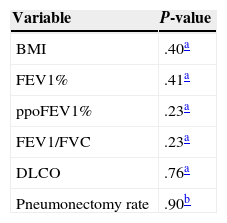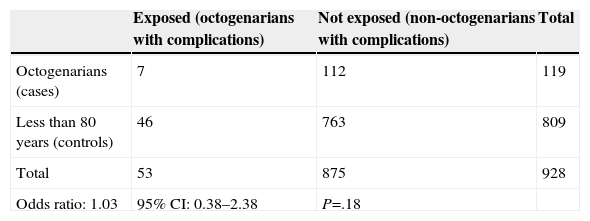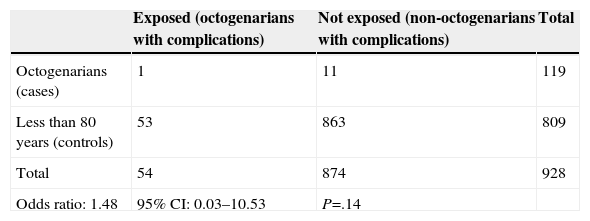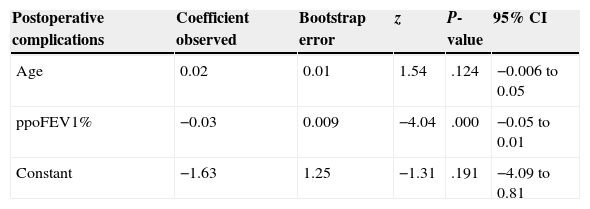Evaluate the restrictiveness of selection criteria for lung resection in lung cancer patients over 80 years of age compared to those applied in younger patients. Compare and analyze 30-day mortality and postoperative complications in both groups of patients.
MethodsCase-controlled retrospective analysis.
Study populationConsecutive patients undergoing elective anatomical lung resection. Population was divided into octogenarians (cases) and younger patients (controls). Variables determining surgical risk (BMI, FEV1%, postoperative FEV1%, FEV1/FVC, DLCO and pneumonectomy rate) were compared using either Wilcoxon or Chi-squared tests. Thirty-day mortality and morbidity odds ratio were calculated. A logistic regression model with bootstrap resampling was constructed, including postoperative complications as dependent variable and age and post-operative FEV1% as independent variables. Data were retrieved from a prospective database.
ResultsNo statistically significant differences were found in BMI (P=.40), FEV1% (P=.41), postoperative FEV1% (P=.23), FEV1/FVC (P=.23), DLCO (P=.76) and pneumonectomy rate (P=.90). Case mortality was 1.85% and control mortality was 1.26% (OR: 1.48). Cardiorespiratory complications occurred in 12.80% of younger subjects and in 13.21% of patients aged 80 years or older. (OR: 1.03). In the logistic regression, only FEV1% was related to postoperative complications (P<.005).
ConclusionSelection criteria for octogenarians are similar to those applied in the rest of the population. Advanced age is not a factor for increased 30-day mortality or postoperative morbidity.
Valorar si los criterios de selección para resección pulmonar por cáncer son más estrictos en pacientes octogenarios que en el resto de la población. Comparar la mortalidad a 30 días y la morbilidad posquirúrgica en los 2 grupos.
MétodoAnálisis retrospectivo de casos y controles. La población se ha dividido en pacientes octogenarios (casos) o de menor edad (controles). Se han comparado las variables determinantes del riesgo quirúrgico (IMC, FEV1%, FEV1ppo%, FEV1/FVC, DLCO y tasa de neumonectomías) mediante la prueba de Wilcoxon o la prueba de Chi.2 Se han calculado las odds ratio en tablas 2×2. Además, se ha construido un modelo de regresión logística con remuestreo, introduciendo como variable dependiente la presencia de complicaciones y como variables independientes edad y FEV1ppo%. La información se recuperó de una base de datos prospectiva.
ResultadosNo se encontraron diferencias significativas en cuanto a IMC (p=0,40), FEV1% (p=0,41), FEV1ppo% (p=0,23), FEV1/FVC (p=0,23), DLCO (p=0,76) ni porcentaje de neumonectomías (p=0,90) entre los 2 grupos de pacientes. La mortalidad en los casos fue 1,85% y en los controles 1,26% (OR: 1,48). La prevalencia de complicaciones cardiorrespiratorias fue 12,80% en menores de 80 años y de 13,21% entre los octogenarios (OR: 1,03). En la regresión logística solo el FEV1% se relacionó con la aparición de complicaciones (p<0,005).
ConclusiónLos criterios de selección de pacientes octogenarios son similares a los del resto de la población estudiada. Tener 80 o más años no se asocia con la mortalidad de la resección pulmonar a 30 días ni con la morbilidad analizada.
Although lung cancer can be detected at any age, the number of diagnoses in patients over the age of 80 is growing.1 In the literature, this population has been associated with a higher incidence of postoperative complications and greater mortality.2 In studies in which the outcomes of anatomic resection in the elderly were similar to those obtained in younger patients, authors have attributed this similarity to more restrictive patient screening.3 In this study, we analyzed our population of octogenarian patients undergoing lung resection, evaluating 30-day mortality and morbidity. Finally, the characteristics of this population were compared with those of younger patients to determine if outcomes were related to more restrictive preoperative screening in octogenarians.
MethodDesignRetrospective case-controlled study.
Study PopulationPatients consecutively scheduled for anatomic lung resection (protocolized segmentectomy, lobectomy, bilobectomy or pneumonectomy) due to lung cancer between January 2002 and December 2013 were included. Data were entered in a prospective database using two-pass verification as quality control. A total of 928 cases were analyzed.
Patient Screening CriteriaBefore surgery, all patients underwent the same tests: physical examination, complete blood count and serum biochemistry, electrocardiogram, chest X-ray, computed tomography (CT) of the chest and abdomen, and bronchoscopy. PET–CT was performed in all patients included since 2007. Invasive mediastinal staging (by mediastinoscopy or endobronchial ultrasound since 2009) was performed if mediastinal lymphadenopathies >1cm were seen on CT and if the mediastinal PET was positive. All patients performed lung function tests, including DLCO since 2009–this test was not routinely requested before then. Patients with suspected coronary disease or ECG suggestive of coronary changes were evaluated with ergometry or stress echocardiogram.
All patients were selected for surgery on the basis of absence of other comorbidities more severe than lung cancer and predicted postoperative FEV1>30% greater than predicted FEV1 for their age, sex and height, and after the case had been individually discussed by a multidisciplinary committee.
Perioperative ProceduresPerioperative management of all study patients was the same, and has been described in detail in earlier publications.4 The surgical approach in all cases was muscle-sparing posterior thoracotomy, or either video-assisted or non-video-assisted axillary thoracotomy. The same group of anesthetists and thoracic surgeons were responsible for all anesthetic and surgical procedures, respectively. Antibiotic prophylaxis consisted of a single dose of 1500mg cefuroxime that could be repeated if surgery was prolonged. Patients were extubated before they left the operating room, and after a few hours in the reanimation unit were transferred to the thoracic surgery ward. Bupivacaine and fentanyl were administered as postoperative analgesia via a thoracic epidural catheter for the first 3 days, followed by oral ibuprofen and paracetamol.
Nursing care and physiotherapy were the same for all patients.
Variables AnalyzedIndependent variables included were age (as a binary variable: older or younger than 80 years), body mass index (BMI), FEV1%, predictive postoperative FEV1% based on the number of non-obstructed lung segments to be removed (ppoFEV1%), FEV1/FVC ratio, DLCO, and pneumonectomy rate. Dependent variables were postoperative cardiorespiratory complications (defined in previous studies4; in short, postoperative onset arrhythmia, nosocomial pneumonia and postoperative atelectasis) and mortality at 30 days or at any time before hospital discharge.
Data AnalysisThe population was divided into 2 groups: octogenarians at time of intervention (cases) and patients younger than 80 (controls). Surgical risk variables were compared using the Wilcoxon test for continuous variables and the Chi-squared test for pneumonectomy rate. To evaluate the association between age group and 30-day mortality or morbidity, the odds ratio and the 95% confidence interval were calculated from 2×2 tables. A logistic regression model with bootstrap resampling was constructed with 50 replicates, including age and ppoFEV1% as independent variables, and postoperative complications, including intraoperative death, as the dependent variable. Data were analyzed using Stata SE 12.1 software (StataCorp, TX, USA).
ResultsBetween January 2002 and December 2013, a total of 928 anatomic lung resections were performed for lung cancer (36 segmentectomies, 736 lobectomies, 64 bilobectomies and 92 pneumonectomies). Of these, 875 were performed in patients younger than 80 years and 53 in patients aged 80 years or more. The median age of the octogenarian group was 80 years (range: 80–86). With regard to surgical risk variables, no differences were found in BMI (P=.40), FEV1% (P=.41), ppoFEV1% (P=.23), FEV1/FVC (P=.23) and DLCO (P=.76) between the 2 patient groups (Table 1). In the control group, 9.94% (87 patients) underwent pneumonectomy, while this procedure was performed in 9.43% (5 patients) of cases (P=.90). Cardiorespiratory complications occurred in 112 controls (12.8%) and in 7 (13.21%) cases (OR: 1.03; 95% CI: 0.38–2.38) (Table 2). Mortality in patients younger than 80 was 1.26% (11 patients), while 1 patient in the octogenarian group died (1.85%; OR: 1.48; 95% CI: 0.03–10.55) (Table 3). In the logistic regression with resampling, ppoFEV1% was associated with postoperative complications (P<.005); age, however, was not (P=.12) (Table 4).
Logistic Regression Model.
| Postoperative complications | Coefficient observed | Bootstrap error | z | P-value | 95% CI |
|---|---|---|---|---|---|
| Age | 0.02 | 0.01 | 1.54 | .124 | −0.006 to 0.05 |
| ppoFEV1% | −0.03 | 0.009 | −4.04 | .000 | −0.05 to 0.01 |
| Constant | −1.63 | 1.25 | −1.31 | .191 | −4.09 to 0.81 |
Number of observations=928.
Replicates=50.
Wald Chi-squared=21.76.
Prob>Chi-squared=0.0000.
Pseudo R2=0.05.
The number of cancer diagnoses in octogenarian patients is growing. Up to 87% of these are early-stage, so anatomic resection remains the best treatment option.5 However, mortality associated with surgery increases proportionally with age,6 and rates of up to 8.1% have been reported in some earlier studies, compared to 1.3% in the under-60 population, 4.1% in the 60–69 age group, and 7% in patients aged from 70 to 79. In more recent series, mortality after lobectomy in patients older than 75 was significantly higher than in patients younger than 75 (1.5% versus 0.3%, respectively), although figures remain low enough to continue to recommend lung resection in this population.7 These latest mortality rates in octogenarian patients are similar to those obtained in our series.
Despite data supporting lung resection in the elderly, attitudes to surgical risk and the concept of therapeutic success differ between octogenarian and younger patients. Many are concerned about complications that could prolong hospital stay or persist after discharge. For others, long-term survival is of less importance than relief of symptoms and maintaining a quality of life similar to that experienced before the procedure.8
Although the prevalence of postoperative complications in our series was around 13%, in most other studies, 20%–60% of patients over 80 years had 1 or more postoperative complication, mainly cardiorespiratory events.9–12 This factor must be taken into account when discussing different treatment options with octogenarian patients, since many may choose a less invasive approach.13
Careful screening of surgical candidates, whether octogenarians or younger patients, has contributed to improved outcomes after anatomic lung resection. Appropriate selection of patients of all ages, based on published clinical guidelines,14 is essential for achieving satisfactory surgical outcomes and for reducing postoperative complications. Standardized patient screening, with discussion of each individual case by a multidisciplinary committee, would explain why the surgical risk variables presented by the octogenarian population in our hospital were similar to those of the younger population.
In our series, logistic regression analysis of the influence of age on the appearance of postoperative complications found no significant differences between the 2 patient groups. However, the influence of ppoFEV1% was statistically significant. This relationship would support the hypothesis that the more functional parenchyma removed, the more the patient's functional capacity and quality of life is compromised.
This study has some limitations: (1) screening bias, since we have no data on patients from either study group who were not referred for thoracic surgery for whatever reasons, and (2) DLCO was not routinely recorded in our database until 2009.14 Therefore, despite this test being one of the main determinants for surgical risk, we could not include it as an independent variable in our regression model. We are aware that the number of patients included in the octogenarian group is small, and that the study has other limitations typical of a retrospective study, but the information was retrieved from a prospective, double entry database, thus limiting considerably the risk of data bias. We are equally aware that our results cannot be generally extrapolated to those obtained by other researchers working with different methodologies.
To conclude, our series shows that 30-day mortality and the risk of cardiorespiratory complications in octogenarian patients are similar to those of younger patients, and that this similarity in outcome is not due to a more restrictive selection of patients aged over 80 years, but rather to the careful screening of all candidates for surgery, irrespective of age. These data may contribute to therapeutic decision-making in patients older than 80, while bearing in mind the specific peculiarities of this group of patients and the findings of the different working groups.
Conflict of InterestsThe authors state that they have no conflict of interests.
Please cite this article as: Rodríguez M, Gómez Hernández MT, Novoa NM, Aranda JL, Jiménez MF, Varela G. Morbimortalidad de la resección pulmonar en pacientes octogenarios con cáncer de pulmón. Arch Bronconeumol. 2015;51:219–222.













